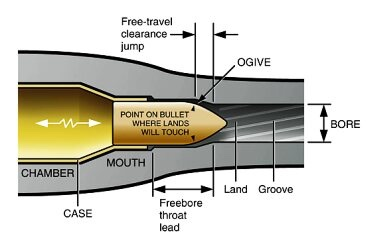5.56mm vs 0.223: What’s the Difference?
Is It Safe to Use 5.56mm Ammo in a 0.223 Gun, or Vice Versa?
Most AR-15 shooters know that AR-15 rifles can come specified as either 5.56mm NATO or 0.223 Remington caliber rifles (as well as others, such as .300 AAC Blackout). Some people will claim that 0.223 and 5.56mm are interchangeable since cartridges listed as either caliber will chamber in either caliber rifle. But are they truly interchangeable? Is it safe to use 0.223 ammo in 5.56mm rifles, or vice versa?
There actually are slight differences between these rounds, though they are fairly similar. First, 5.56mm was designed for use in military rifles, while 0.223 caliber were made explicitly for civilian use. The 5.56mm cartridge was designed to develop a maximum chamber pressure of 58,000 psi (pounds per square inch), while the 0.223 was designed to develop a max of 55,000 psi. This means that using a 5.56mm round in a weapon designed for 0.223 would introduce higher chamber pressures than what the gun was designed for… which can lead to problems.
Why the higher pressures on the 5.56mm NATO round? This is caused by several factors, none of which are obvious to the casual user. The 5.56mm cartridge has a slightly longer throat dimension (the distance between the end of the case and the point where the rifling begins), which allows the 5.56mm round to hold slightly more powder than the 0.223. The 5.56mm case is also slightly thicker, though its external dimension is the same. This means that the internal dimension is slightly smaller… so more powder, in a slightly smaller volume, is going to lead to higher pressures when that powder is ignited.
Another difference between the two calibers is likewise subtle… this has to do with chamber dimensions. One subtle but basically harmless difference is that the diameter of the chamber is just slightly larger for 5.56mm NATO than it is for 0.223 Remington. The reason for this is that the 5.56mm caliber is intended for military use; the very slightly larger chamber will make the weapon more ‘forgiving’ under dirty conditions (meaning a little less likely to jam because of a dirty chamber). This difference is small enough that the casual shooter will not detect it.
However, there is a much more meaningful (though still subtle) difference in chamber dimensions between the two calibers. The place in the previously mentioned throat distance where the rifling narrows down to the barrel diameter begins and the rifling engages is called the “leade” (shown in the illustration). The 5.56mm NATO cartridge (and chamber) is designed with nearly twice the leade of the 0.223. Though this dimensional difference is hard to detect, it makes a big difference if the wrong caliber is used. When the bullet moves forward and engages the rifling, it meets resistance, and is briefly slowed down. This distance (sometimes called the ‘jump’ distance) is carefully designed for a proper match between the gun and the ammunition. If the 5.56mm cartridge is used in a 0.223 gun, the jump is smaller and the bullet engages the rifling grooves just a tiny bit sooner than it was designed to, which causes the pressure to rise above what it was designed for.
We can see that these design differences (case wall thickness and leade) which are small and hard to detect can make a big difference in the chamber pressures that each cartridge develops. What does that mean to the shooter? Will this cause the gun to explode? There’s a decent chance that it will not explode; when weapons are designed (much like any other potentially dangerous device) they are engineered with a factor of safety, to provide a margin of error against conditions that are a little outside of the design parameters. However, it is NOT good practice to depend on that factor of safety, as the chamber ‘could’ burst… you should always use ammunition that is explicitly designed for the weapon that you are firing it from. Using ammunition that is higher powered than what the gun was designed for creates higher stresses on the weapon and can lead to catastrophic failure. This may or may not happen the first time, but can lead to long-term problems.
So what does this all mean? A good rule of thumb for safety is that it’s safe to use 0.223 Remington ammunition in a rifle chambered for 5.56mm NATO, but it is not safe to use 5.56mm NATO ammo in a weapon chambered for 0.223 Remington. Running 0.223 ammo in a 5.56mm NATO-chambered rifle may (arguably) result in a slight loss in accuracy (due to the longer jump distance, where the round could be slightly unstable), but is perfectly safe. Using 5.56mm NATO in a 0.223 Remington is just not safe. The only safe way to use 5.56mm ammo in a 0.223 gun is to first take that 0.223 caliber weapon to a good gunsmith, and have the chamber bored to the proper dimensions to allow use of the 5.56mm round. For most people, the simple choice is to just use ammunition that was designed for your weapon, and you won’t go wrong.
Like this article? Please share and leave your comments below!
Select Fire Training Center (SFTC) is the premiere training center and indoor shooting range facility in Northeast Ohio. Dedicated to offering a top notch facility with highly skilled instructors, a wide range of classes and a state-of-the-art shooting range experience. We are here to serve your needs, make you feel welcome and we do this by offering you true customer service by friendly, knowledge people.






